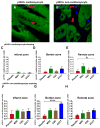A Combination of Allogeneic Stem Cells Promotes Cardiac Regeneration
- PMID: 29145950
- PMCID: PMC5796680
- DOI: 10.1016/j.jacc.2017.09.036
A Combination of Allogeneic Stem Cells Promotes Cardiac Regeneration
Abstract
Background: The combination of autologous mesenchymal stem cells (MSCs) and cardiac stem cells (CSCs) synergistically reduces scar size and improves cardiac function in ischemic cardiomyopathy. Whereas allogeneic (allo-)MSCs are immunoevasive, the capacity of CSCs to similarly elude the immune system remains controversial, potentially limiting the success of allogeneic cell combination therapy (ACCT).
Objectives: This study sought to test the hypothesis that ACCT synergistically promotes cardiac regeneration without provoking immunologic reactions.
Methods: Göttingen swine with experimental ischemic cardiomyopathy were randomized to receive transendocardial injections of allo-MSCs + allo-CSCs (ACCT: 200 million MSCs/1 million CSCs, n = 7), 200 million allo-MSCs (n = 8), 1 million allo-CSCs (n = 4), or placebo (Plasma-Lyte A, n = 6). Swine were assessed by cardiac magnetic resonance imaging and pressure volume catheterization. Immune response was tested by histologic analyses.
Results: Both ACCT and allo-MSCs reduced scar size by -11.1 ± 4.8% (p = 0.012) and -9.5 ± 4.8% (p = 0.047), respectively. Only ACCT, but not MSCs or CSCs, prevented ongoing negative remodeling by offsetting increases in chamber volumes. Importantly, ACCT exerted the greatest effect on systolic function, improving the end-systolic pressure-volume relation (+0.98 ± 0.41 mm Hg/ml; p = 0.016). The ACCT group had more phospho-histone H3+ (a marker of mitosis) cardiomyocytes (p = 0.04), and noncardiomyocytes (p = 0.0002) than did the placebo group in some regions of the heart. Inflammatory sites in ACCT and MSC-treated swine contained immunotolerant CD3+/CD25+/FoxP3+ regulatory T cells (p < 0.0001). Histologic analysis showed absent to low-grade inflammatory infiltrates without cardiomyocyte necrosis.
Conclusions: ACCT demonstrates synergistic effects to enhance cardiac regeneration and left ventricular functional recovery in a swine model of chronic ischemic cardiomyopathy without adverse immunologic reaction. Clinical translation to humans is warranted.
Keywords: allogeneic; cardiac stem cell; ischemic cardiomyopathy; mesenchymal stem cell.
Copyright © 2017 American College of Cardiology Foundation. Published by Elsevier Inc. All rights reserved.
Figures







Comment in
-
Combination Cell Therapy for Ischemic Cardiomyopathy: Is the Whole Greater Than Sum of Its Parts?J Am Coll Cardiol. 2017 Nov 14;70(20):2516-2518. doi: 10.1016/j.jacc.2017.09.1065. J Am Coll Cardiol. 2017. PMID: 29145951 No abstract available.
References
MeSH terms
Grants and funding
LinkOut - more resources
Full Text Sources
Other Literature Sources

